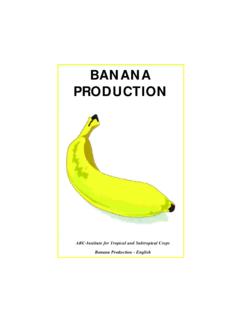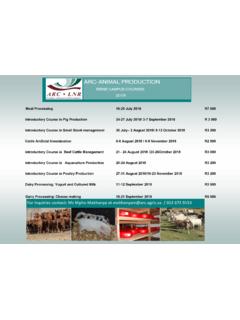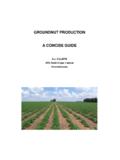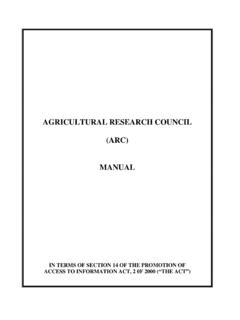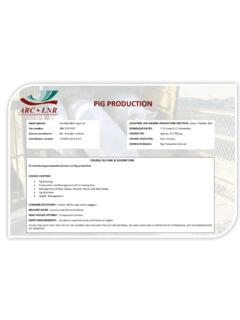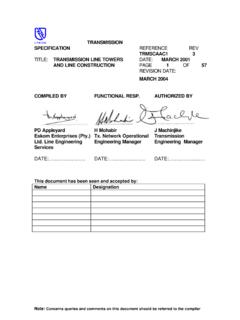Transcription of Maize production - Agricultural Research Council
1 Maize productionJ an du PlessisDEPARTMENT: AGRICULTUREREPUBLIC OF SOUTH AFRICA2003 compiled by Directorate Agricultural Information ServicesDepartment of Agriculturein cooperation with ARC-Grain Crops InstitutePrinted and published by the department of Agricultureand obtainable from Resource CentreDirectorate Agricultural Information ServicesPrivate Bag X144, Pretoria, 0001 South AfricaThis publication is available on the web: provided byARC-Grain Crops InstitutePrivate Bag X1251, Potchefstroom 2520 Tel. (018) 299 6100 Fax (018) 294 71461 INTRODUCTIONM aize (Zea mays L.) is the most important graincrop in South Africa and is produced throughoutthe country under diverse Maize production depends on thecorrect application of production inputs that willsustain the environment as well as agriculturalproduction.
2 These inputs are, inter alia, adaptedcultivars, plant population, soil tillage,fertilisation, weed, insect and disease control,harvesting, marketing and financial developed countries, Maize is consumed mainlyas second-cycle produce, in the form of meat,eggs and dairy products. In developing countries, Maize is consumed directly and serves as staplediet for some 200 million people. Most peopleregard Maize as a breakfast cereal. However, ina processed form it is also found as fuel (ethanol)and starch. Starch in turn involves enzymaticconversion into products such as sorbitol,dextrine, sorbic and lactic acid, and appears inhousehold items such as beer, ice cream, syrup,shoe polish, glue, fireworks, ink, batteries,mustard, cosmetics, aspirin and 8,0 million tons of Maize grain areproduced in South Africa annually on approximately3,1 million ha of land.
3 Half of the production consistsof white Maize , for human food needs 450 to 600 mm of water per season,which is mainly acquired from the soil moisturereserves. About 15,0 kg of grain are produced foreach millimetre of water consumed. At maturity,each plant will have consumed 250 l of water. Thetotal leaf area at maturity may exceed onesquare metre per assimilation of nitrogen, phosphorus andpotassium reaches a peak during flowering. Atmaturity the total nutrient uptake of a singlemaize plant is 8,7 g of nitrogen, 5,1 g ofphosphorus, and 4,0 g of potassium. Each ton ofgrain produced removes 15,0 to 18,0 kg ofnitrogen, 2,5 to 3,0 kg of phosphorus and 3,0 to4,0 kg of potassium from the other crop utilises sunlight more effectivelythan Maize , and its yield per ha is the highest ofall grain crops.
4 At maturity, the total energyused by one plant is equivalent to that of 8 29315 W electric globes in an number of kernel rows may vary betweenfour and 40, depending on the variety. Up to1 000 kernels may be produced by a single spite of only one pollen grain being required toproduce one kernel, each tassel produces some25 000 000 pollen grains, i. e. 25 000 grains foreach kernel. As a result, up to 40 % of thetassels in a planting may be lost without affectingpollination, other factors remaining , GROWTH AND DEVELOPMENTRoot systemThe plant has a profusely branched, fine rootsystem. Under optimal conditions, the total rootlength, excluding the root hairs, can reach 1 500 root growth is not restricted, the root systemof a mature plant extends approximately 1,5 mlaterally and downwards to approximately 2,0 mor even deeper.
5 The permanent root system hasadventitious and prop roots. Adventitious roots3develop in a crown of roots from nodes below thesoil surface. Normally four to six adventitiousroots are formed per band. After tasselling, proproots develop into bands from the first two tothree aerial nodes. These roots are comparativelythick, pigmented and covered with a waxy roots have the dual function of providingsupport to the plant and taking up root hairs occur on young plants. Roothairs increase root surface area that is exposedto the soil, and play an important role inabsorption of water and eight to 20 leaves that may form are arrangedspirally on the stem, and they occur alternately intwo opposite rows on the stem.
6 The Maize leaf isa typical grass leaf and consists of a sheath,ligules, auricles and a blade. The leaf blade islong, narrow, undulating and tapers towards thetip and is glabrous to hairy. The leaf is supportedby a prominent mid-rib along its entire occur in rows along the entire of the leafsurface. More stomata occur on the underside ofthe leaf than on the upper surface. On the uppersurface motor cells are present. These large,wedge-shaped cells occur in rows, parallel to andbetween the rows of stomata. During moistconditions, these cells rapidly absorb water,become turgid and unfold the leaf. During warm,dry weather, the cells quickly lose their turgorwith the result that leaves curl inwards exposinga smaller leaf surface to Maize stem varies in height from less than 0,6 min some genotypes to more than 5,0 m (in extremecases) in others.
7 The stem is cylindrical, solid andis clearly divided into nodes and internodes. Itmay have eight to 21 internodes. The internodesdirectly below the first four leaves do notlengthen, whereas those below the sixth, seventhand eighth leaves lengthen to approximately 25,50 and 90 mm, respectively. Tillers may developfrom nodes below the soil lateral shoot bearing the main ear developsmore or less from the bud on the eighth nodeabove the soil surface. The five or six budsdirectly below the bud give rise to rudimentarylateral shoots of which one or two develop toproduce and female flowers are borne on the sameplant as separate inflorescences. Male flowers areborne in the tassel and female flowers on the earThe Maize ear (the female inflorescence)terminates one or more lateral branches, usuallyhalfway up the stem.
8 Bracts enclose the ear. Thesilk of the flowers at the bottom appear first andthereafter those on the upper part of the remains receptive to pollen for approximatelythree weeks but after the tenth day, kernelFIG. 1. Maize kernelThe Maize kernel consists of an endosperm,embryo, a pericarp and tip cap (Fig. 1). Theendosperm contains the main carbohydrates. Theembryo contains the parts that give rise to thenext generation, while the pericarp and tip capenclose the entire endosperm contains approximately 80 % ofthe carbohydrates, 20 % of the fat and 25 % ofthe minerals, while the embryo contains about80 % of the fat, 75 % of the minerals and 20 %of the protein found in the starch part of the kernel is used in foodsand many other products such as adhesives,clothing, and pharmaceutical tablets and in paperproduction.
9 The starch can be converted intosweeteners and used in products such as softdrinks, sweets, bakery products and jams, toname but a oil from the embryo is used in cooking oils,margarine and salad dressings. The protein, hullsand soluble part of the Maize kernel are used inanimal and poultry capMaize6 Kernels can be of the dent or flint (round) kernels have a dented crown, which is formedduring drying when the softer starch in the middleof the kernel shrinks faster than the outer moretranslucent sides. The dent kernel has two flat sidesopposite each other and the one side contains embryo contains all the parts that give rise tothe next kernels can be round or flat in appearance andcontain mainly translucent starch, with only a smallpart of soft starch in the middle, hence the pericarp and tip cap enclose the entire with a high percentage of translucent ofhard endosperm is preferred by the dry millingindustry, because it produces more of the popularhigh-quality and high-value products sought afterthan does soft 2.
10 Chemical composition of the Maize kernelComponents%Carbohydrates84,0 Protein10,9 Fat 4,5 Minerals 1,3 TABLE 1. Composition of Maize kernelsComponentsDent kernelsFlint kernels%%Endosperm hard54,2 Endosperm soft27,5 Endosperm total81,780,6 Embryo11,013,5 Pericarp and tip cap 7,2 5,87 EarTasselStemBrace rootsFIG. 2. Mature Maize plantLeavesRoots8 Growth and developmentDifferent growth stages are numbered 0 to stage 0 lasts from planting of the seed upto when the seedling is just visible above the soilsurface. Growth stage 10 is reached when theplant is biologically mature (Fig. 2).Growth stage 0: from planting to seedemergenceDuring germination, the growth point and theentire stem are about 25 to 40 mm below the soilsurface.
